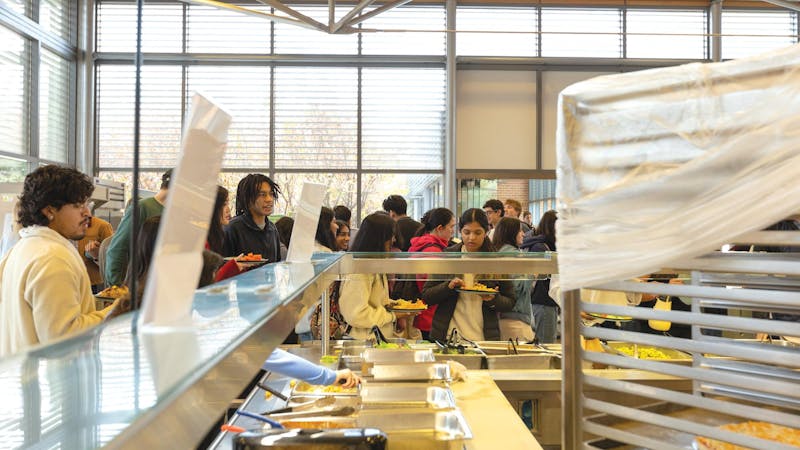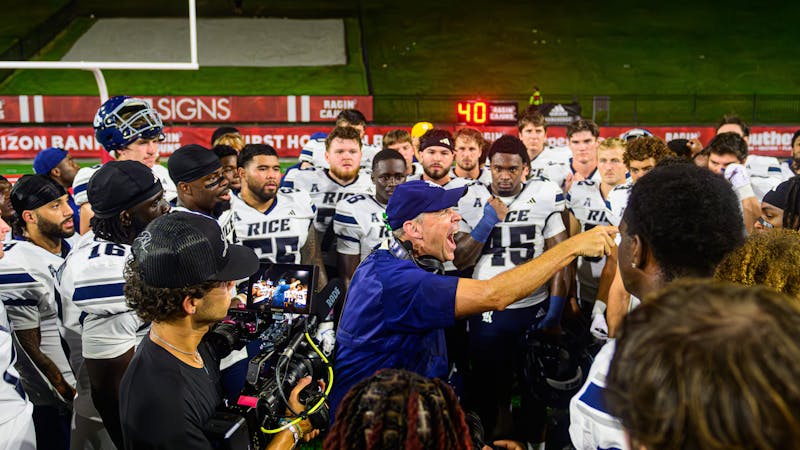The State of the University
For the full article with graphs and information about individual department budget cuts, please see this pdf.
Six months after markets began to tumble in October of last year, both citizens and financial institutions worldwide are still waiting for a rebound. Rice University is among these ranks, struggling to stay on top of its finances while still maintaining long-term goals and its health as a top-tier institution, President David Leebron said.
As markets have continued to worsen, denying many speculators the predicted bounce back, Rice has made new cuts and budgetary adjustments to stay in the black.
Rice began officially responding to the financial crisis in January, instituting a staff hiring freeze that lasted two months and asking all departments to cut non-compensation expenses by 1 percent, a reduction that is still in place. At the time, the two measures were predicted to save the university $600,000.
Leebron recently evaluated the measures as "very successful," saying they netted the university several millions of additional reserves, more than anticipated.
"The goal was to get people to take a deep breath and pause, before we made decisions that we might have wished we didn't make," Leebron said.
At the beginning of February, the university requested that all department budgets for the next fiscal year be reduced by 5 percent through cuts in unrestricted funding. Unrestricted funding does not include salaries.
Across campus, departments are taking diverse approaches to achieve the cuts. For many departments, finding room to trim costs has been difficult.
"The fact is, this is not a place with a lot of fat," Political Science Department chair Rick Wilson said about his department's efforts to reach spending-reduction targets.
Furthermore, not all divisions have been hit with the same reductions, since the 5 percent cut comes from the department level. For this reason, although the School of Humanities cut its unrestricted funding by 5 percent, the Visual and Dramatic Arts Department was asked to cut its budget by 24 percent, VADA chair Brian Huberman said.
Smaller departments faced the 5 percent budget cut by trimming down some of their programs. Since the Sociology Department does not have a graduate department, its budget is less than most of the other departments in the social sciences, Sociology Department chair Elizabeth Long said.
"We cut from the lecture fund and will work to collaborate with other groups on campus for co-sponsorship of lectures," she said. "In a sense, we're cutting down the number of guest lecturers, but we're building community."
In some cases where the 5 percent cut cannot be achieved through unrestricted funding alone, the university is asking departments to consider if any unfilled faculty or staff positions can be eliminated. The History Department, for example, trimmed three "unclaimed" positions, chair Martin Weiner said, adding that 90 percent of the budget cuts in the Humanities Department were due to such personnel sacrifices.
Leebron acknowledged that the 5 percent cut was difficult to reach, partially due to the large amount of expenses devoted to salaries - two-thirds of the overall university budget.
"We know that a 5 percent cut may sound modest to some, but in most schools and departments this requires very difficult decisions," Leebron wrote in an April 3 e-mail sent to all faculty and staff.
Forman said that this could be particularly challenging in cases where salaries accounted for most of the budget.
"If 90 percent of the budget is in salary, 10 percent is in supplies and expenses, and to cut 5 percent of the budget means we have to cut supplies and expenses in half," Forman said. "It's kind of an extreme case but not unrealistic."
However, Leebron said a spirit of cooperation has made the cuts easier to face.
"I think it's been very successful in the sense that across the university, people have understood that not because of anything the university has done but just because of difficult economic circumstances that we face, we have hard and difficult decisions to make," Leebron said.
In January, Rice also modified its financial aid structure, raising the no-loan cap to $80,000 in order to make more families eligible for loan-free financial aid. Earlier this month, the parking rates for the next academic year were announced, with no annual rate increase from those in place this year.
Last month, a 5 percent tuition increase was announced for next year's entering freshman class, though Leebron noted that the increase was smaller than those made in previous years.
"Our message to students and families is that we are balancing two important priorities during these difficult times: keeping a Rice education accessible and affordable for students, while generating the resources we need to provide one of the best undergraduate educations in the country," Leebron said in his e-mail.
However, despite the university's coordinated efforts, Rice is still facing challenges. The endowment, which represents 45 percent of university spending, is down 20 percent since spring of last year, according to Vice President for Finance Kathy Collins.
Large endowments at universities throughout the country fell an average of 20 percent between July and November of last year, according to The Chronicle of Higher Education. Though Rice's endowment is doing markedly well compared to the stock market, which is down 37 percent from its place in April of last year, its decline still places significant limitations on university spending, since endowment spending is capped at 6.5 percent of the fund's three-year running average, Collins said.
"We have benefited greatly over the years from having a very large endowment," Leebron said. "It also means that when things go very badly, there is a larger set of adjustments to make."
The university is currently budgeting based on a model that sees the endowment fall an additional 5 percent this year, and then gain 5 percent next year before returning to historic growth rates. Leebron noted that such a scenario was a planning model, not a prediction.
"We're now going on the basis of what I used to say were pessimistic assumptions, and I now say are more realistic assumptions," he said.
Leebron suggested that additional budgetary cuts would be made in the next three fiscal years in order to manage the university's finances.
"At the end of the day, we have to live within our means," he said. "It's vital to the future of the university that we not overreact, but that we react."
Nonetheless, Leebron maintained that Rice is currently in a good position financially, with student increases and rising donations both helping the university make up losses.
Student applications for the freshman class were up 14 percent this year, Leebron said, passing 10,000 for the first time in the university's history. Additionally, the increases in undergraduate class sizes planned in the Vision for the Second Century will increase tuition revenue for the university, Leebron said.
Furthermore, the Centennial Campaign has helped to increase charitable donations to the university by 14 percent in the past year, he said.
Leebron said the greatest sign that the university was still on its feet financially was its continued cycles of faculty growth. Although some departments have given up currently unfilled positions, the university is also adding to its faculty, hiring 22 tenure and tenure-track positions so far this recruiting year.
"We are seizing opportunities," Leebron said. "We are trying to achieve our goals. We have not shut down hiring processes, which are, at the end of the day, the single most important thing we do."
Looking with a hopeful eye at university finances, Leebron encouraged the Rice community to continue to weather the financial storms with a strong spirit.
"I remain optimistic that we'll make some additional cuts, but that in a few years we'll see a bounce back," he said. "Some retrenchment is necessary, but I think so far we can be able to manage this without too much pain, and I think a special kind of respect is due to the people who form this Rice community."
Margeux Clemmons, Cindy Dinh, Michelle Phillips, Josh Rutenberg, Jocelyn Wright and Jaclyn Youngblood contributed to this article.
More from The Rice Thresher

Over 1,000 students petition against new meal plan
When Konstantin Savvon opened the Housing and Dining email announcing the new unlimited meal plan, he was instantly concerned about the impact on off-campus students like himself.

Rice football wins season opener under new coach
For the first time since 2018, Rice football opened its season with a victory. Scott Abell was soaked with yellow Powerade following a 14-12 win on the road Saturday against the University of Louisiana at Lafayette, which won 10 games and made it to the Sun Belt Conference championship last season.

Acting like an athlete: Rice basketball alum takes on Broadway
Underneath Chadd Alexander’s Broadway costume, there’s ankle tape and wrist braces — same protective gear he wore as a walk-on basketball player at Rice, though now he’s performing eight shows a week in the ensemble of “Harry Potter and the Cursed Child” instead of running conditioning drills in Tudor Fieldhouse.

Please note All comments are eligible for publication by The Rice Thresher.